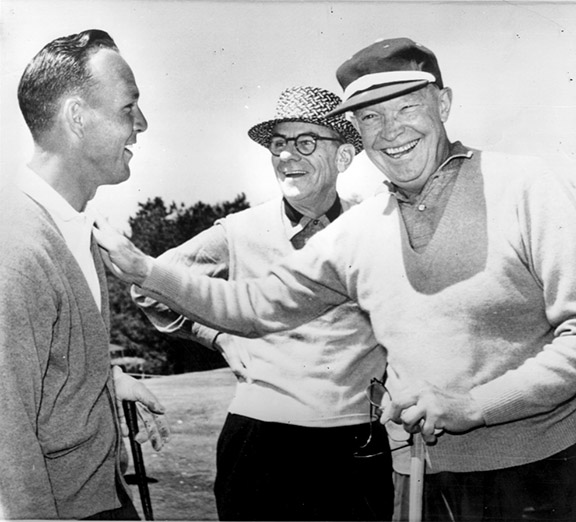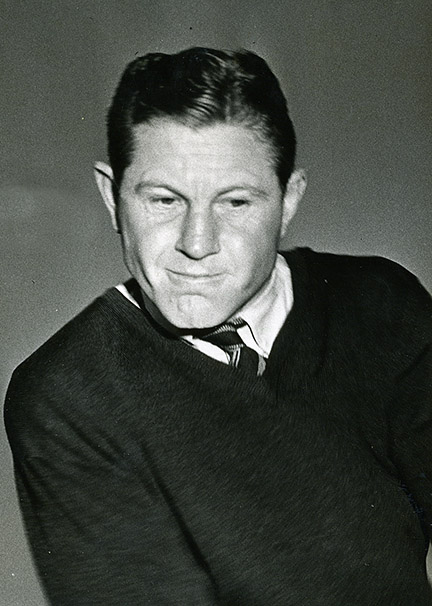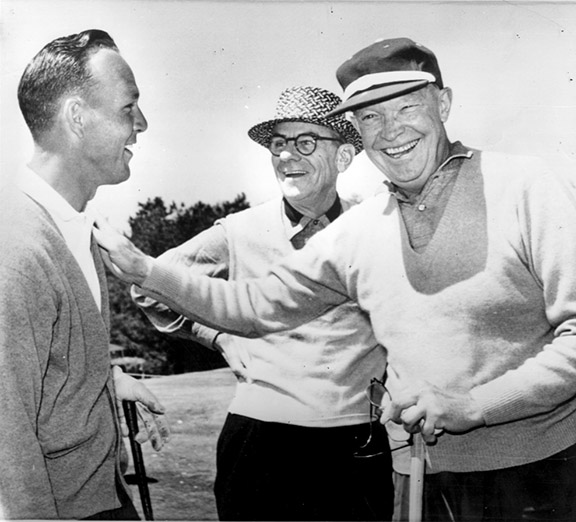RANDOM GOLF FOOTNOTES from John Fischer —
The Prequel to the 1934 Masters
It’s April, and to golfers worldwide, it means Masters time. The azaleas are in bloom, the tall loblolly pines bend slightly in the breeze, the fairways are a sea of green and Rea’s Creek and the lake in front of the 15th green are a shimmering blue.
The course was designed by Dr. Alister MacKenzie, noted for courses like Cypress Point, Royal Melbourne and Pasatiempo, who had been a camouflage expert in World War I, and Bob Jones, who won 13 national championships by 1930, with Jones modestly referring to himself as a “junior assistant” to MacKenzie.The Augusta National Golf Club course opened for play in 1933, and Jones thought he might be able to lure the United States Golf Association to designate it for a U.S. Open, but it would be too hot and muggy in Augusta in June when the Open was normally held, so Jones and his friend, Clifford Roberts, a New York banker who was working on the financing of the course, decided to hold their own tournament.
Jones would invite all his golfing friends from his tournament days to play, so there could be a top-notch field. Roberts wanted to call the event the Masters Tournament because of the expected quality of the field, but Jones thought the Masters too presumptuous and wanted to call the event the Augusta National Invitation Tournament. Roberts acceded to Jones’ choice of name, but the press didn’t. From the beginning it was the Masters to the press and public. In 1939, Jones gave in and went with the Masters as the official name of the tournament.

In 1934, Masters invitations went out late. At one point, Jones wanted a smaller field of elite players. Several couldn’t come. Gene Sarazen was going on an exhibition tour of South America, Francis Ouimet and some other top amateur players were off to the Walker Cup in St. Andrews, Scotland, and for others travel was too difficult. Twelve amateurs accepted invitations to play in 1934. Jones’ heart was in amateur golf, and he wanted them to be involved in his tournament, a tradition which continues today.
Augusta was a small, dusty Southern city, served by rail and two-lane roads. There were only two hotels of note, the Bon Air and the smaller Partridge Inn, both of which catered to the winter trade which was already moving farther south to Florida. Even during the Civil War, on Union General Sherman’s march to the sea, Augusta wasn’t attacked.
All that was about to change. Bob Jones was a national sports hero winning 13 national championships. He’d stopped playing competitive golf in 1930 after winning the four national tournaments open to him: the U.S. Open, the British Open, the U.S. Amateur and the British Amateur which he’d never managed to win before. With no worlds left to conquer, he retired at age 28 from tournament play. He was married and had children and was practicing law in Atlanta.
Jones did not plan to play in the 1934 Masters. He’d hung up his clubs and only played recreational golf. Cliff Roberts told Bob he had to play. It would border on being rude to those of his friends from past competitive golf who were coming to Augusta just to see him…and to see him play in competition. Jones reluctantly agreed, and the newspapers went wild. The “Emperor Jones” who’d dominated open and amateur golf in the 1920s was returning to competition. In those years, it was Jones against the field, and few could beat him. Now “the field” wanted a piece of Jones.
The press was behind Jones. What a story. Jones returns and beats the field again. After all, why not? He co-designed the Augusta course, knew it like the back of his hand, held the course record of 65, and recently returned a score of 67. But most who were supporting Jones seemed to have forgotten a Jones comment, “There’s golf and there’s tournament golf, and the pair bear little resemblance.” Jones knew the difference and hadn’t played any tournament golf for three and one-half years.
It may seem a little odd today, but the press was quoting betting odds from bookies to show that Jones was the favorite, and the press was a big piece of the 1934 Masters. Grantland Rice was probably the best-known sportswriter in the country. His daily column, The Sportslight, was syndicated in 100 newspapers. A graduate of Vanderbilt University, Rice majored in the classics, studying Latin and Ancient Greek (the form of Greek used for The Iliad and The Odyssey), not necessarily what one might consider for a career in sports journalism. But for Rice, it became the basis for athletes as heroes who fought great battles in the ring, the diamond, the football field and the golf course. Rice made heroes of Babe Ruth, Jack Dempsey, Red Grange and, of course, Bob Jones, and helped in creating the so-called “Golden Age of Sports.”
At the time it wasn’t considered a conflict of interest or an ethical problem that Grantland Rice was an original member of Augusta National. His assignment from Cliff was to encourage all the baseball writers in Florida for spring training to stop in Augusta on the train ride home and cover the Masters. And Rice did a good job. Among others who covered the first Masters were Alan Gould, Associated Press Sports Editor; Henry McLemore, United Press; Stuart Cameron, United Press Sports Editor; O.B. Keeler, Atlanta Journal golf writer; and, of course, Grantland Rice.
Behind all the hype and excitement about the first Masters and Jones returning to competition, there were serious problems. First, the club had trouble finding members. These were depression years; money was hard to come by and joining a club which was hard to get to and only open from October to May was a stretch for many people.
The club was short of funds. It was having trouble meeting its weekly payroll of $200. Many contractors hadn’t been paid and Dr. MacKenzie was still owed $1,000 of his design fee. The city of Augusta kicked in some money to support the tournament on the basis that tournament attendees would spend money with city businesses. The tournament purse was $5,000, with a first prize of $1,500 to the winner. Only the top 12 finishers were paid any prize money, not unusual for the times.
Roberts, who was a partner in the banking firm of Reynolds & Co. in New York, ran the club finances and oversaw every aspect of the club operations and planning for the tournament, always considering cost and benefit. One could buy a badge for the entire tournament or purchase daily tickets.
To bring in more paying gallery members, Cliff decided to start practice rounds on the Sunday before the tournament started on Thursday, and broke tradition by playing the third round on Saturday and the fourth round on Sunday. Normally, tournaments on the nascent golf tour played 18 holes on Thursday and Friday and 36 on Saturday, to avoid any problems with Sunday “blue laws” which differed by state, but generally required stores to be closed and prohibited Sunday sales of liquor. Cliff saw Sundays as an extra day of much needed gate receipts.
To entice attendance, on Thursday morning of tournament week there was a chipping and putting contest on the practice green with tournament play in the afternoon; on Friday morning there was an iron play contest on the old practice area between the 18th and ninth holes; and on Saturday morning there was a long driving contest. Sunday was devoted entirely to the final round of the tournament. Cliff wanted everyone, players and paying customers to have a good time and see what the best players in the world could do.
Earlier in the year, Cliff had an unusual idea. On Wednesday afternoon, all contestants would be invited to play in another tournament at Augusta, a foursome match at medal play, a real pipe-holder for the lead up to the main event the following day. Foursomes are very popular in Great Britain and involve two players playing a single ball, alternating shots.
Before the start of play, the two partners must decide on who drives on the odd-numbered holes (player “A”) and the other will drive on the even numbered holes (Player “B”). Player A drives; Player B hits the second shot which goes in a bunker; Player A hits a nice shot from the bunker toward the pin; Player B putts and the ball hangs on the edge of the cup; Player A taps the ball in (if Player B walks up and backhands the ball an inch into the cup, the team would be assessed a two stroke penalty for playing out of turn). There are other rules situations which can arise — a provisional ball, ball out of bounds, playing with a club from your partner’s bag, and so on, so be sure to bring a copy of the Rules of Golf.
Almost all the players in the Masters played in the foursomes event. It’s not clear how partners were selected, but newspapers reported that Bob Jones selected Ross (Sandy) Somerville, a Canadian amateur who had won the 1932 U.S. Amateur Championship, as his foursomes partner. It may be because Jones didn’t like to talk during competition and Somerville spoke only twice on the golf course, on the first tee, “How do you do,” and on the final green, “Thank you very much.”
Jones was off his game, missing several short putts, and he and Somerville shot 38-38=76, four over par. They three-putted three times and Jones missed an 18-inch putt on the 18th hole. Jones went to the practice green to see if he could recapture some of his old putting magic and noted that somehow the cups on the practice green seemed bigger.
Jones was known for his putting prowess and his favorite putter, “Calamity Jane.” Calamity Jane had been given to Jones by Jimmy Maiden, bother of Stewart Maiden who was Jones’ instructor. Calamity Jane was short, 33-1/2 inches and very lightweight at 15-1/2 ounces. It was an older club even when Maiden gave it to Jones. Over the years the face of the club was worn down by continuous polishing with an emory cloth, so J. Victor East of Spalding made six exact duplicates and Jones picked the one he liked best.
In the 1934 Masters, Jones was playing Spalding steel shafted clubs which he had helped design, including a Calamity Jane putter. His putting was so erratic in the tournament proper that Jones sent to Atlanta for a rusty old blade putter which had belonged to his mother to use in the final round. His putting improved greatly.
The foursome event winners were Bill Burke and John Golden with a score of 32-35=67, five under par. They were awarded a prize, probably a medal or small trophy, but the newspapers didn’t describe what it was.
Foursomes require a lot of thinking on who should drive on the odd or even holes, especially on a course like Augusta where a great deal of strategy is involved. The longest and straightest driver, the best putter, the best sand player, etc., must be taken into account. Most golfers know the Augusta course pretty well either from having been to the Masters or having watched it on television. Who, dear reader, would you want to drive on the odd-numbered holes? Your humble author would have the longest and straightest golfer driver on the odd-numbered holes, mainly because of 13 and 15, where a good drive could lead to a birdie or an eagle. Long accurate drives on Holes 1, 5, 7 and 9 would be helpful, and the same with 11 and 17.
In addition to the strategy of how to play each of the holes, one had to know the strengths, and weaknesses, of his partner and leave him in the best position for his next shot, even though it might not be what you would do if you were hitting the next. While foursomes partners are allowed to seek advice from each other, or their caddies, there is one unspoken rule: never criticize your partner’s play. You were to play the round in as friendly a manner as possible and encourage him.
Most of the players and Augusta members stayed at the Bon Air Hotel, and the players received a reduced room rate. On Wednesday after the foursomes event, everyone headed to the Bon Air for a dinner and another special event, the Masters Calcutta. A Calcutta is a gambling event where each player is auctioned off. The cash is held until the end of the tournament, and the person who “bought” the contestant who won the Masters got the pot of money. It was customary for the holder of the winning ticket to divide the cash with the winner of the tournament. Sometimes the Calcutta pool would pay more places, akin to a horse race: win, place and show.
In 1934, it was reported that Jones went for $750 in the Calcutta. Paul Runyan said the real number Jones went for was $16,000. Runyan felt the added pressure to win for his backers in the pool hurt Jones’ play in the Masters. The Masters Calcutta moved to the Augusta clubhouse and was stopped in 1952. But not really. It just moved back to the Bon Air Hotel.

Horton Smith, known as an excellent putter, won the inaugural Masters with a score of 284, four under par. Jones finished 10 strokes behind in 13th place. It was Bob’s best finish in the Masters. He stopped playing after 1948 due to health problems but would continue as host until shortly before he died in 1971.
Smith won $1,500 for finishing first. The club didn’t have the funds to pay, but several members chipped in so the prize money could be distributed on time.
My, how the times have changed.

